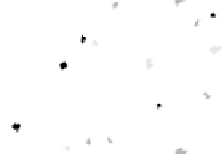Information Technology Reference
In-Depth Information
Note that we had to adapt the pick-up probabilities on the sites adjacent to an
obstacle. Neighbors belonging to an obstacle, are counted as if holding a corpse.
However, no modification was needed as concerns deposition.
4.2 Sorting
In the presence of many types of corpses, our algorithm sorts the corpses into
different clusters, eventually forming one cluster per type. There is no rule that
forbids corpses of different type from being deposited next to each other. Only
the marking discriminates between types of corpses.
t
=10
000
t
=40
000
t
= 100
000
Fig. 2.
Snapshots at various iteration times. The domain size is 290
×
200. There are
1500 = 3
×
500 corpses of three types, and 1500 ants. Probabilistic pick-up is used.
Snapshots of a simulation run with three types of corpses
N
0
=3
×
500 and
1500 ants are shown in figure 2. Probabilistic pick-up was used with the same
parameters as above. Ants carrying a corpse of a given type are blind to other
types. The dynamics looks like three different clustering algorithms evolving
simultaneously in the same arena with one third of the corpses and ants.
4.3 Clustering Dynamics
In this section, we measure the e
A
ciency of the clustering process as well as
cluster compactness. To this end, we measure how fast the number
N
(
t
)of
clusters goes to 1 and we monitor the density of the largest cluster. In section
4.1, we gave a definition of a cluster and how to compute its area and density.
We first compare in figure 3, the density of the largest cluster for probabilistic
and deterministic pick-up. We observe in both cases a rapid increase of density
during the first few thousand iterations. Throughout this first stage, small clus-
ters appear. Then, in the probabilistic case, the density slowly increases from
around 0
.
75 to approximately 0
.
85, while in the deterministic case, it fluctuates
around 0
.
3. These fluctuations are due to the brittleness of the clusters. The
main observation is that added intelligence yields more compact clusters.
Next, we look at the formation speed as a function of the number
M
of ants.
We ask the following question: is the spontaneous emergence of a single cluster
due to some elaborate collaboration between the ants?






